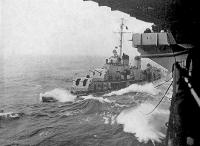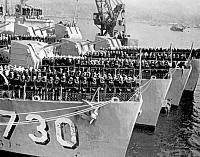 |
| The DeHaven refuels off the Coast of Korea-click for larger image |
General MacArthur conceived the idea for a decisive counterstroke that would cut off the enemy advance and force them to withdraw. It would be a brilliant but risky amphibious landing directed at the Inchon-Seoul region, the strategic solar plexus of Korea.
The venture was designated Operation Chromite. D-day was set for September 15, 1950.
Beginning at D-day minus 10, a series of diversionary moves was made to mislead the Communists. On the east coast, the cruiser Helena and destroyers Brush and Maddox shot up shipping and trenches below Yongdok. At Pusan, marines were given a not-so-secret lecture on the hydrography of Kunsan, a port city about halfway up the west coast, knowing full well that word would filter back to the North Koreans. Kunsan was a credible place to establish a beachhead.
The USS Badoeng Strait, the British carrier HMS Triumph, and four destroyers were a key part of this feint. Sortie after sortie of U.S. Marine and British planes devastated railroad bridges, rolling stock, and electrical transformer stations. A British cruiser and two British destroyers moved in close to shore to begin bombardment of potential landing sites.
Operation Chromite placed a particularly heavy load on the Navy. Total strength amounted to some 230 ships of all shapes and sizes. Except for a few gunnery ships held back to support the perimeter, it included all combatant units available in the Far East. Just to carry the troops to battle would require more than 120 amphibious vessels, while the rest of the ships were involved in gunfire, air support, screening, minesweeping, and a myriad of other duties.
Most remarkable was the speed with which preparations were carried out. From the time the final operational orders were issued on September 2, the largest fleet since World War II was assembled. Yet despite the pressures under which the operation was carried out, there were few mistakes.
Inchon was the port city for Seoul, capital of South Korea. An amphibious landing there would be fraught with difficulty. For one thing, the approach to the city was through a narrow and tortuous channel that restricted the movement of shipping for the last thirty-four miles of the approach. For another, the harbor was cursed with extraordinarily high tides, rising and falling as much as twenty-eight feet twice daily. Only at high tide could a landing be negotiated; at low tide the area was nothing but mud flats.
Only two beaches were suitable for landing-Blue Beach on the southern edge of the city and Red Beach four miles away on the western shore. Piers and seawalls lined the beaches, and their assault would require scaling ladders.
An island called Wolmi Do presided over the inner harbor and split the two landing beaches. Connected by a causeway to the mainland, it sat there like a cork in a bottle. The island was heavily fortified and would have to be neutralized before an amphibious landing could successfully take place. That job fell to the U.S. Marines.
The operation would have to be carried out in full daylight, thereby eliminating the possibility of surprise.
 |
| The Collett, DeHaven, Swenson and Mansfield line up for Presidential Unit Citation-click for larger image |
The softening-up process began with six veteran destroyers proceeding up the narrow channel in single file-the Mansfield, DeHaven, Swenson, Collett, Gurke, and Henderson. These were the so-called sitting duck destroyers, intended to draw fire from hidden gun positions on Wolmi Do. They were followed by the U.S. cruisers Rochester and Toledo and two British cruisers, the Jamaica and Kenya. The Borland brought up the rear. Combat air patrol circled overhead. The weather was clear, the sea calm.
The Gurke anchored only eight hundred yards away from Wolmi Do, the other destroyers in their assigned positions. Although there was boat traffic in the harbor and activity in the city, Wolmi Do showed no signs of life. Lookouts scanned the island in fearful silence trying to detect the telltale signs of concealed gun emplacements. For several minutes nothing happened, then destroyers commenced deliberate fire on the island's fortifications and the Inchon waterfront.
Some minutes later, enemy batteries opened up on the American ships. Fire was concentrated on the Swenson, Collett, and Gurke, all of which took direct hits. Heaviest damage was to the Collett, which took four 75mm hits, one of which pierced the engineroom and fractured a low-pressure steam line. Another plowed into the plot room and disabled the ship's computer, wounding five men.
Three hits were made on the Gurke, and one on the Swenson. Among those killed was LTJG David Swenson, nephew of the officer for whom the ship was named.
Bombardment of Wolmi Do resumed. From ten in the morning until four in the afternoon six destroyers pulverized the island with shellfire, expending some seventeen hundred rounds of 5-inch ammunition. This time, not a shot was heard in retaliation from the island's defenses. The gunfire appeared to have done the job. Shrouded in smoke, it was now ready for capture by the marines. For their gallantry, all six ships received the Navy Unit Commendation and the Korean Presidential Unit Citation.
The USS Missouri (BB-63) arrived in Korean waters late in the evening of September 14 after dodging several typhoons, having made a full-speed run from the East Coast of the United States. Adm. A. E. Smith, commander of Task Force 95, wrote, "When I was informed that the Missouri would join Task Force 95, I planned to use her, the Helena, and several destroyers as a diversionary effort on the east coast, on the same day as the initial marine landings on the west coast at Inchon."'
The Mighty Mo, as she was affectionately known, celebrated her arrival by firing fifty rounds of 16-inch fire at a bridge near Samchok, using a helicopter spot. The results were excellent.
Shortly after midnight, the attack force started up the channel, navigating by radar. Again, destroyers led the way, followed by an LSD, three tank-loaded LSUs, and the fast transports Bass, Diachenko, and Wantuck. Cruisers brought up the rear, now joined by the command ship Mount McKinley.
North of Wolmi Do, Mansfield, Swenson, and DeHaven concentrated their pre-invasion bombardment on the northern shore of Inchon. The Collett, Gurke, and Henderson bombarded the southern shore of Inchon. Cruisers concentrated on the two landing beaches. Marine aircraft bombed, strafed, and rocketed the landing area. Fifteen minutes before landing time, three rocket ships, each with a thousand 5-inch spin-stabilized rockets, let go.
At 6:28 A.M. the bombardment group ceased fire to permit the landing parties to hit the beaches. The first troops moved ashore at 6:33 in a scene of smoke, dust, and devastation. They met negligible resistance.
The ships and planes continued to provide fire support throughout the day as additional troops and supplies were put ashore. By day's end the basic objective was accomplished. Casualties were relatively light-222 killed or wounded-a modest price for such an important objective.
| Copyright © 1997-2023 USS DeHaven Sailors Association 2606 Jefferson Avenue, Joplin MO 64804 Contact Us |